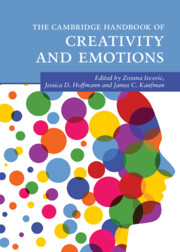Book contents
- The Cambridge Handbook of Creativity and Emotions
- Cambridge Handbooks in Psychology
- The Cambridge Handbook of Creativity and Emotions
- Copyright page
- Dedications
- Contents
- Figures
- Tables
- Contributors
- Acknowledgments
- Creativity and Emotions
- Part I Methods in the Study of Creativity and Emotions
- Part II The Development of Creativity
- Part III Emotions and the Creative Person
- 12 Emotion Traits and Creativity
- 13 Gender Differences in Creativity and Emotions
- 14 Affect in Pretend Play and Creativity
- 15 Creativity, Emotions, Emotion Regulation, and Aging
- 16 Interpersonal Relationships, Social Emotions, and Creativity
- Part IV Emotions and Creative Products
- Part V Emotions and Creativity at School and Work
- Index
- References
16 - Interpersonal Relationships, Social Emotions, and Creativity
from Part III - Emotions and the Creative Person
Published online by Cambridge University Press: 16 February 2023
- The Cambridge Handbook of Creativity and Emotions
- Cambridge Handbooks in Psychology
- The Cambridge Handbook of Creativity and Emotions
- Copyright page
- Dedications
- Contents
- Figures
- Tables
- Contributors
- Acknowledgments
- Creativity and Emotions
- Part I Methods in the Study of Creativity and Emotions
- Part II The Development of Creativity
- Part III Emotions and the Creative Person
- 12 Emotion Traits and Creativity
- 13 Gender Differences in Creativity and Emotions
- 14 Affect in Pretend Play and Creativity
- 15 Creativity, Emotions, Emotion Regulation, and Aging
- 16 Interpersonal Relationships, Social Emotions, and Creativity
- Part IV Emotions and Creative Products
- Part V Emotions and Creativity at School and Work
- Index
- References
Summary
The chapter summarizes the role of interpersonal relationships in all forms of creativity: creative self-beliefs, abilities, activities, and achievements. We analyze the problem from two perspectives: processual and developmental. In the beginning, we characterize social emotions’ role in self-regulation of the creative process. Further, we describe the influence of significant others across lifespan. We present the meaning of parents and siblings for creativity in the early stage of life. Next, we move to the importance of romantic relationships and parenthood for adulthood creativity. Finally, we focus on the role of predecessors and successors in professional creativity with particular attention to their meaning for creative self-beliefs. In summary, we discuss the role of interpersonal relationships and social emotions through the journey from creative potential to creative behavior.
- Type
- Chapter
- Information
- The Cambridge Handbook of Creativity and Emotions , pp. 299 - 318Publisher: Cambridge University PressPrint publication year: 2023
References
- 1
- Cited by



